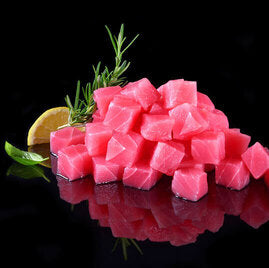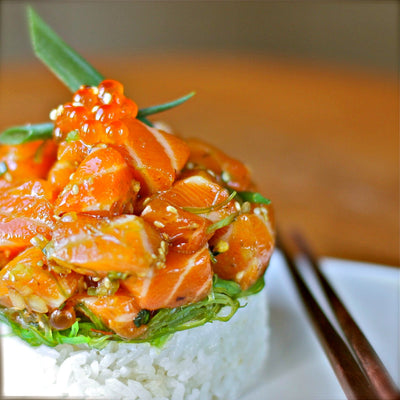Poke Tuna vs. Sushi: A Delicious Comparison of Two Iconic Cuisines

Poke Tuna vs. Sushi: A Comparison
Poke tuna and sushi are two of the most celebrated dishes in the world of seafood cuisine. While both feature raw fish and boast global popularity, they differ in their preparation, presentation, and cultural significance. Whether you’re a sushi connoisseur or a poke enthusiast, understanding the nuances of these iconic dishes will deepen your appreciation for their artistry.
This article takes a deep dive into the origins, ingredients, and serving styles of poke tuna and sushi, helping you decide which dish suits your next meal.
Understanding Poke Tuna: A Hawaiian Delicacy
What Is Poke Tuna?
Poke (pronounced poh-kay) is a traditional Hawaiian dish featuring raw, cubed fish, often tuna, marinated with ingredients like soy sauce, sesame oil, and seaweed. Served over rice or greens, poke emphasizes simplicity and fresh flavors.
According to Chef Roy Choi, “Poke represents Hawaii’s history and culture in a bowl—a fusion of native, Asian, and global influences.”
Key Features of Poke Tuna
- Casual Presentation: Often served as a bowl with customizable toppings.
- Focus on Freshness: Tuna is minimally seasoned to highlight its natural flavors.
- Versatility: Can include add-ins like avocado, mango, or spicy mayo.
For premium-quality tuna for poke, try:
Exploring Sushi: A Japanese Art Form
What Is Sushi?
Sushi is a Japanese cuisine that combines vinegared rice with raw fish, seafood, or vegetables. Unlike poke, sushi often requires precise techniques and artistic presentation.
Masaharu Morimoto, a renowned sushi chef, describes sushi as “a harmonious balance of flavor, texture, and aesthetics—a true culinary art.”
Types of Sushi
- Nigiri: A small rice ball topped with raw fish.
- Maki: Rolls of rice and fillings wrapped in seaweed.
- Sashimi: Thin slices of raw fish served without rice.
For sushi-grade tuna, consider:
Poke Tuna vs. Sushi: What’s the Difference?
| Feature | Poke Tuna | Sushi |
|---|---|---|
| Origin | Hawaii | Japan |
| Main Ingredient | Raw, cubed tuna | Raw fish or seafood with vinegared rice |
| Presentation | Bowl format with toppings | Artfully arranged portions |
| Preparation | Quick and simple | Requires advanced techniques |
| Customization | Highly customizable | Limited customization |
| Served With | Rice, greens, or noodles | Rice or as standalone fish |
Which Dish Is Healthier?
Both poke and sushi are healthy, nutrient-rich options, but their nutritional profiles differ slightly.
Health Benefits of Poke Tuna
- High in Protein: Supports muscle repair.
- Rich in Omega-3 Fatty Acids: Promotes heart and brain health.
- Customizable Base: Choose quinoa or greens for fewer carbs.
Health Benefits of Sushi
- Rich in Vitamins: Seaweed and vegetables add extra nutrients.
- Low-Calorie Options: Sashimi provides pure protein with no rice.
- Portion Control: Smaller servings help regulate calorie intake.
The American Heart Association recommends eating fish twice a week for optimal health.
How to Choose the Best Tuna for Poke and Sushi
High-quality tuna is essential for both poke and sushi. Look for:
- Sushi-Grade Label: Ensures it’s safe for raw consumption.
- Bright Color: Indicates freshness.
- Firm Texture: Should be free of odor or sliminess.
Recommended products:
How to Make Poke Tuna at Home
Ingredients You’ll Need
- Sushi-grade tuna (Shop Here)
- Soy sauce, sesame oil, and rice vinegar for marinade
- Toppings: Avocado, cucumber, edamame, and sesame seeds
Instructions
- Dice the tuna into uniform cubes.
- Prepare a marinade with soy sauce, sesame oil, and a splash of rice vinegar.
- Mix the tuna with the marinade and let it sit for 15–20 minutes.
- Assemble a bowl with rice, greens, and your favorite toppings.
How to Make Sushi at Home
Essential Tools and Ingredients
- Bamboo rolling mat
- Sushi rice and seaweed sheets
- Sushi-grade tuna (Bluefin Tuna)
Instructions
- Prepare the rice with vinegar, sugar, and salt.
- Lay a seaweed sheet on the rolling mat.
- Spread rice evenly and add sliced tuna or vegetables.
- Roll tightly and slice into bite-sized pieces.
FAQs About Poke Tuna and Sushi
1. Can I use the same tuna for poke and sushi?
Yes, as long as it’s sushi-grade, it’s safe for both dishes.
2. Which is easier to make at home?
Poke is easier and requires less equipment or technique.
3. Can poke be made without raw fish?
Yes! Substitute tuna with cooked shrimp, tofu, or watermelon for a vegetarian option.
4. Is sushi always raw?
No. Sushi can also feature cooked ingredients like eel, crab, or tempura shrimp.
5. How long can raw poke or sushi last?
Both are best consumed fresh but can be refrigerated for up to 24 hours.
Why Choose Both? A Culinary Adventure Awaits
Poke tuna and sushi both offer unique dining experiences:
- Poke provides a casual, customizable meal perfect for quick lunches or beach days.
- Sushi, with its artistry and precision, elevates dining into an elegant experience.
For those who love seafood, there’s no need to choose—embrace the best of both worlds!
Get Inspired with Global Seafoods
Ready to start your culinary adventure? Explore premium-quality tuna and get inspired with recipe ideas from the Global Seafoods YouTube Channel.
Shop Now:
Conclusion
Poke tuna and sushi are more than just dishes—they are cultural treasures that celebrate the beauty of raw fish and fresh ingredients. Whether you’re indulging in the customizable flavors of poke or the meticulous craftsmanship of sushi, both cuisines promise an unforgettable experience.
Discover the finest sushi-grade tuna at Global Seafoods and bring these iconic dishes to your table today!
Also in News

Columbia River Steelhead | Life Cycle, Conservation & Facts
Columbia River steelhead are one of the most resilient salmonid species, embarking on an incredible migration from freshwater to the ocean and back. Learn about their spawning habits, juvenile development, oceanic journey, and conservation efforts. Discover why steelhead are a prized fish for both anglers and seafood lovers.

Mastering Dover Sole: Cooking & Serving Guide for a Gourmet Experience
Dover Sole is a culinary delight known for its mild flavor and tender texture. Whether you're pan-frying for a crispy finish, baking for a healthy meal, or grilling for a smoky touch, this guide provides expert tips on preparing, cooking, and serving Dover Sole. Elevate your seafood dishes and enjoy gourmet flavors at home.

Cocktail Caviar Pairings: Best Drinks to Complement Exquisite Caviar
Pairing caviar with the right cocktail enhances both flavors, turning any occasion into an indulgent experience. Learn expert tips on pairing champagne, martinis, Moscow mules, and more with the perfect caviar selection.





